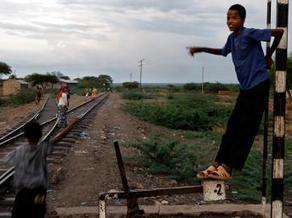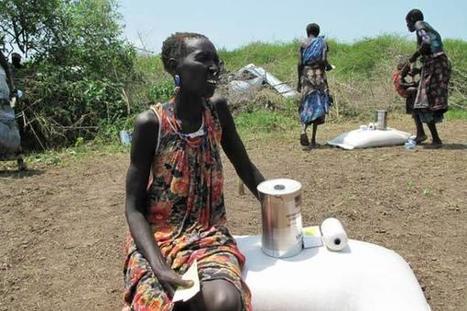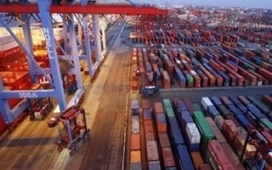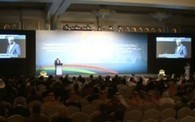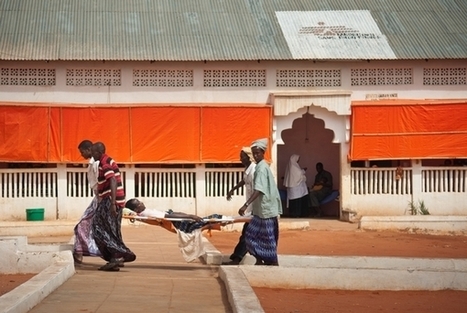 Your new post is loading...
 Your new post is loading...

|
Scooped by
Robin Landis
August 27, 2013 2:34 AM
|
In the first of a five-part series on railways in Africa, we visit Ethiopia, the first country in Africa to have a railway. The French-built railway connected the capital Addis Ababa to the Red Sea port of Djibouti. However, the old diesel railway is now being replaced by a Chinese-built electrified railway, a grand plan that seeks to transport the country’s commercial exports to its neighbouring countries... A train hasn’t left Addis Ababa for six years. But this major new train line is expected to open between Addis Ababa and the port of Djibouti in 2016. This will be the first train line that forms a major piece of the 5,000 km transportation network planned to connect the landlocked country to neighbouring countries. “We are looking to connect to North Sudan, Central Sudan and South Sudan. From Ethiopia to Djibouti. From Ethiopia to Kenya, the Lamu corridor will be connected and it will be one of the best routes between Ethiopia and Kenya. The main purpose of the railway is to connect Ethiopia economically to its neighbouring countries.” Two Chinese companies are involved in the project.

|
Scooped by
Robin Landis
August 22, 2013 3:45 AM
|
The South Sudan Common Humanitarian Fund (CHF) has set aside $33 million for critical aid to vulnerable people and host communities affected by crisis in South Sudan. Throughout the end of the year, people displaced by violence, returnees, refugees and vulnerable host communities will draw assistance for the funds to receive clean water and sanitation, education, healthcare, mine clearance and protection. The funds will also pay for key logistics and emergency telecommunications in deep field locations. ...more than 4 million people are affected by food insecurity in South Sudan, over 70,000 have been internally displaced since the beginning of the year and the country currently hosts some 220,000 refugees, mostly from Sudan. The CHF is a tool that provides funding for urgent humanitarian action and rapid response to emergencies. Donors contribute revenue over the course of the year for onward allocation to aid agencies when resources are needed most. “To date, the CHF has not channelled resources towards food assistance, as the scale of those requirements would have depleted the fund’s resources. Organizations distributing food, therefore, rely on other funding to meet the needs of the most vulnerable food-insecure,” continued Mr. Lanzer. Since January, Australia, Belgium, Denmark, Ireland, Norway Sweden and the United Kingdom have all provided generously to the fund. With the new allocation of $33 million, the CHF will have channelled around $90 million to non-governmental organizations and UN agencies in 2013. “Across South Sudan, the World Food Programme is helping around 1.7 million people, but it requires an additional $84 million to be able to reach all of the estimated 2.85 million people it has planned to help this year,” concluded Lanzer.

|
Scooped by
Robin Landis
August 22, 2013 3:01 AM
|
...Mombasa is losing regional market share to Tanzania as years of underinvestment in transport infrastructure mean railways and roads can’t cope with the rising volumes moving in and out of the facility. The harbor serves land-locked nations including Rwanda, Democratic Republic of Congo, Uganda and South Sudan, which are among the world’s fastest-growing economies... ...Neighboring Tanzania is spending at least $10 billion constructing a new port at Bagamoyo, 37 miles northwest of Dar es Salaam, where it’s upgrading an existing facility. The commercial capital, Dar es Salaam, handled 12.1 million metric tons of cargo last year, about 45 percent less than Mombasa, according to data compiled by Trademark East Africa... The Kenyan port’s loss of business to Dar es Salaam has grown since post-election violence in the first two months of 2008 disrupted trade flows. Ethnic clashes across the country hampered traffic by rail and road from the port, causing fuel shortages and a spike in inflation in neighboring nations... ...“Firms are going to choose to use the facilities that will handle the goods with the most speed. It is natural that we have to work towards improving our port in order to attract these firms.”

|
Scooped by
Robin Landis
August 20, 2013 2:32 AM
|
...The team will conduct an environmental assessment of the impacts of the fire, including sampling and analysis to determine the possible effects of fire residues and extinguishing agents on the environment... The team of experts has been mobilized through a partnership of the UN Environment Program (UNEP) and OCHA, known as the Joint Environment Unit, based in Geneva. Domains of expertise of team members include disaster management, environmental assessment, sampling and waste management, fire fighting, chemistry, and airport logistics...

|
Scooped by
Robin Landis
August 20, 2013 2:17 AM
|
[Written by Dr. Andreas Wieland, researcher in the field of operations and supply chain management. He heads the Kühne Foundation Center for International Logistics Networks at the Department of Technology and Management, Technische Universität Berlin, Germany] ++++++++++++++++++ As part of the Kühne Foundation’s certificate program on humanitarian logistics, I have, again, been teaching logistics and supply chain management modules in East Africa during the last couple of weeks. This year, the program was held at the University of Dar es Salaam and the National Institute of Transport in Dar es Salaam, Tanzania, as well as at Makerere University Business School in Kampala, Uganda. A new report, recently published by the World Food Programme (WFP), gives a good real-life overview of humanitarian logistics. Particularly, it demonstrates how WFP (1) deliver goods, how they (2) assist the humanitarian community, (3) innovate supply chain management, (4) develop capacity, and (5) partner with other organizations. WFP’s logistics strategy, “Driving the Supply Chain”, includes four priority areas: Emergency Preparedness and Response, Controls and Risk Reduction, External Service Provision, and Food Assistance Initiatives. It becomes apparent that humanitarian and commercial supply chains are highly interlinked and can learn from each other.

|
Scooped by
Robin Landis
August 19, 2013 10:15 AM
|
On August 19, the world recognizes the commitment and dedication of humanitarian workers as it celebrates World Humanitarian Day. In South Sudan, WFP is distributing urgent food assistance to tens of thousands of people who have fled their homes to escape a resurgence of fighting in Jonglei State. Here are the stories of two WFP staff members who make this complex operation possible.

|
Scooped by
Robin Landis
August 16, 2013 7:44 AM
|
The introduction of the electronic systems which is the first ever in the East and Central African region marks the beginning of paperless customs clearance operations at the port that will eventually cut down dwell time to five days from around nine to 15 days.

|
Scooped by
Robin Landis
August 14, 2013 7:02 AM
|
What do you think the world needs more of? Sponsor a word. Make it a reality. World Humanitarian Day is the beginning of a month long, first of its kind project to turn words into currency. Come back on 19 August to share a word and make it a reality for millions of people in need around the world. WORLD HUMANITARIAN DAY.ORG

|
Scooped by
Robin Landis
August 13, 2013 10:54 AM
|
WFP CAR -- Interview with Housainou Taal, CD ...the World Food Program has chosen to overcome the threat and is scaling up its operations inside the country, strengthening its presence on the ground, reopening suboffices and hiring more staff to deliver and monitor food aid. Devex spoke to Housainou Taal, WFP country director in Bangui, whose job is to try to respond as quickly as possible to the rapidly worsening humanitarian emergency in the lawless Central African Republic, where a starving and fearful population faces a dilemma: continue living hidden in the bush or return to crime and human rights violations in urban areas. Most of the displaced are farmers that will probably be unable to return to their fields in time to plant crops for the harvest season. ..."We have launched a new special operation [to increase] WFP transport capacity by 240 tons by bringing in some additional trucks. That will provide more reliable means to access beneficiaries and also to support partners. … We will have a logistics cluster coordinator working not only with WFP, but also with partners [and] an emergency telecommunications program that will help provide Internet and other services to NGOs and local communities in specific field locations..."

|
Scooped by
Robin Landis
August 13, 2013 3:06 AM
|
...the UAE has rightly chosen [Kenya and Tanzania], as they serve as a convenient communication hub and corridor between countries of East Africa and the Middle East, and have more developed infrastructure than most other African states, in terms of ports and airports. “Given the UAE's huge investment strengths and its strategic location, which connects African trade to many countries of the world, especially the Asian continent, the two sides can establish a strong partnership in many fields, such as transportation, particularly air transport and mining...Today, the UAE is considered the largest transit point of trade for many African countries, including Kenya. With the expected application of a comprehensive tariff union among the GCC countries by 2015, this role may advance rapidly and provide significant support for GCC-Africa trade.” ...there is a “huge” scope for economic and investment cooperation between the UAE and Africa adding that the public and private sectors need to make the right decisions so that both the contributing parties benefit mutually. “The enthusiasm and rapid response from both Kenya and Tanzania to the UAE initiative is a good reason for optimism,” he said.

|
Scooped by
Robin Landis
August 12, 2013 9:06 AM
|
Regional logistics firm will be the first company to use new road between Egypt's Erqan and Sudan's Dongola. Company also plans to open new logistics hub.
Al Abbas Transport, one of the foremost transport and logistics firms in the region announced today it has expanded its logistics network with the addition of its latest route between Egypt's Erqan and Sudan's Khartoum. Al Abbas' new route coincides with the opening of the Egypt-Sudan overland link connecting Erqan to Sudan's northern city of Dongola...
"Our new logistics hub will facilitate the processing of commodities, goods and merchandise between Egypt and Sudan as well as ultimately destinations further into Africa such as Ethiopia, Kenya and Tanzania. This better serves our customers by providing them timely and efficient cargo delivery to their intended destinations."

|
Scooped by
Robin Landis
August 9, 2013 3:21 AM
|
Lost medical paperwork and irregular access to prevention and treatment services during a conflict or natural disaster can disrupt the "commodity supply chain" for condoms, harm reduction equipment like clean syringes, and antiretroviral therapy (ART) used to treat HIV. Though the World Health Organization (WHO) has prioritized HIV commodity procurement in emergencies, people living with HIV are still often cut off from service providers. "How does someone in an emergency situation access ART? The clinic might be destroyed, the staff displaced or distressed. What happens then?" [Gary Jones, UNAIDS]... ...even when ART is available, people still have problems accessing it due to barriers that are present even during non-emergency periods. [Henia Dakkak, UNFPA]. As a result, targeted culturally-appropriate services become even more critical for most-at-risk populations during emergencies to ensure access and adherence to ART.

|
Scooped by
Robin Landis
August 7, 2013 8:34 AM
|
The proposed Single Customs Territory (SCT) for EAC which will ensure taxes are collected from first point of entry, has stimulated contrasting reactions from the private sector in Uganda and Kenya... ...Under SCT, taxes are collected at the first point of entry. In this case taxes on imports to Uganda and other hinterland states would all be collected at Mombasa and then shared among the states. However, in Kenya, reports indicate that Kenyan clearing agents and warehouse operators are up in arms against the proposed regulation, arguing that it will lead to job losses. Kenya International Freight and Warehousing Association chairman Boaz Makomere said more than 700 Kenyan clearing and forwarding companies will lose business to Uganda and Rwanda if the new rule takes effect. Makomere said more than 500,000 Kenyans who are both directly and indirectly employed in the transit trade and transport sector will also lose their jobs. The new regulations will allow Uganda, Rwanda and South Sudan to position customs officials at the Mombasa Port.
|

|
Scooped by
Robin Landis
August 27, 2013 2:30 AM
|
HIGHLIGHTSOne-third of humanitarian funding from private sourcesHumanitarians “very nervous” about private sectorPrivate sector offers skill, capacity - not just moneyNeed to assess added value and impact of partnerships ...Large UN agencies like the World Food Programme (WFP), the UN Children's Fund (UNICEF) and the UN Refugee Agency (UNHCR) have in recent years created well-staffed units dedicated to engaging the private sector. The Central Emergency Response Fund, managed by OCHA, has seen the number of private donors rise from two to 22 between 2006 and 2010.
Since a strategy was put in place at WFP in 2008, the private sector has become its seventh largest donor. It remains a "drop in the bucket" compared to funding from governments, but WFP aims to garner $1 billion in commitments per year from the private sector within 5-10 years, according to Ashraf Hamouda, who heads WFP's partnerships and business development work in the Middle East, North Africa, Eastern Europe and Central Asia....

|
Scooped by
Robin Landis
August 22, 2013 3:07 AM
|
...The group of businesses participating in the AidEx Developing World Supplier Zone — an area of 25 free stalls designed to help businesses from developing countries reach an international buying audience — is now urging aid agencies to carry out procurement policy reviews that would compare the cost, delivery time and social benefits of obtaining goods and services through local providers. They are also calling for the removal of conditions that tie donors to procurement in donor countries... ..."It's vital for aid organisations to seriously consider locally developed solutions in their procurement, as these companies' offerings have already been tried and tested 'on the ground'," said Grant Gibbs, project manager at Hippo Water Roller, a water technology project in South Africa..."Superimposing First World business models can underestimate differences in African infrastructure — particularly at the rural level — and lead to inefficiencies."
Simon Lucas, CEO of Reltex Africa, a humanitarian relief materials supplier based in Kenya, said the benefits of the organisation's location in Mombasa, for example, are that it "can easily access raw materials and re-export finished goods through supply chain routes across East Africa...Thishas led to reduced transportation times and decreased environmental impact for humanitarian aid deliveries."

|
Scooped by
Robin Landis
August 20, 2013 2:40 AM
|
Heads of State from Rwanda, Uganda and Kenya will later this month meet to discuss the modalities of financing the railway line that is expected to connect the three countries. According to ... the national coordinator of the trilateral initiative that is championing the project, a proposal on how the project will be funded has been prepared and it will be tabled before the heads of state for discussion and possible adoption. "It's a joint proposal and the heads of state will deliberate on all the issues agreed on during a conference held in Entebbe (Uganda) in June. Kenya has advanced in mobilising the funds especially from China," Mukaruliza said. The former Rwanda EAC minister said that the funding proposal will include other projects like the oil pipeline that would run from Mombasa to Eldoret to Kampala and to Rwanda. The rail line project that is expected to be completed in 2018, is estimated to cost $3.5 billion. The three member countries will jointly mobilise funds to implement the project...

|
Scooped by
Robin Landis
August 20, 2013 2:21 AM
|
...[National Association of Freight and Logistics (NAFL)] acts as an umbrella organisation for logistics companies in Dubai and our main aim is to upgrade and raise the standard of professionalism in Dubai. We maintain contacts with similar freight/logistics associations across the world. Several years earlier we formed a training institute that offers modular vocational training programmes. It provides certification that is valued across the world. It is also recognised by Fiata...

|
Scooped by
Robin Landis
August 20, 2013 2:13 AM
|
Fedha and Liu normally start their day by briefing staff members on the day’s agenda and security situation. Then they visit food distribution sites, contact government authorities for access to a certain area, coordinate with other humanitarian groups, and wrap up with paperwork. But both admit insecurity, matched with sometimes delayed response and lack of staff members with specific skills, make it very difficult to operate in Sudan.

|
Scooped by
Robin Landis
August 19, 2013 8:13 AM
|
The UAE Ministry of Foreign Affairs, global ports operator DP World and Abu Dhabi Ports Company (ADPC) announce they are co-convening the third international counter-piracy conference in Dubai on September 11-12. Their joint hosting of the conference demonstrates the vital importance of public and private sector coordination in the fight against maritime piracy both on and off shore. More than 500 participants comprising foreign ministers, senior government officials, executives of global maritime-sector companies, and leading experts will convene for the two-day event entitled: Countering Maritime Piracy: Continued Efforts for Regional Capacity Building. Building capacity in the region includes addressing piracy in the short term through effective security initiatives, including co-ordination between international navies and merchant vessels, and longer term initiatives that support the development of local economies. The humanitarian impact of piracy on seafarers and their families continues to be a focus, and a highlight of this year’s conference will be a discussion with Captain Juwaid Saleem, a former captive of pirates in Somalia, and his family, who will share their experiences.

|
Scooped by
Robin Landis
August 14, 2013 8:03 AM
|
14 August -- After working continuously in Somalia since 1991, the international medical humanitarian organisation Médecins Sans Frontières (MSF) today announced the closure of all its programmes in Somalia, the result of extreme attacks on its staff in an environment where armed groups and civilian leaders increasingly support, tolerate, or condone the killing, assaulting, and abducting of humanitarian aid workers... ...MSF will be closing its medical programmes across Somalia, including in the capital Mogadishu and the suburbs of Afgooyeand Daynille, as well as in Balad, Dinsor, Galkayo, Jilib, Jowhar, Kismayo, Marere, and Burao. More than 1,500 staff provided a range of services, including free basic healthcare, malnutrition treatment, maternal health, surgery, epidemic response, immunisation campaigns, water, and relief supplies...

|
Scooped by
Robin Landis
August 14, 2013 1:55 AM
|
...Meanwhile, a three-day tea convention will later this month be held in Kigali. It will bring together over 200 delegates from the East African Tea Trade Association (EATTA) mainly tea sector stakeholders. Producers, brokers, tea packers and warehousemen, tea buyers and scholars from East and Central Africa will also attend. It is also expected to attract foreign direct investments into the sector and showcase Rwanda as a global player in the tea industry and other sectors, such as trade logistics, financing and insurance.

|
Scooped by
Robin Landis
August 13, 2013 3:08 AM
|
MORE than 71 per cent of roads passing through Arusha Region are made of tarmac and the rest are gravel. Tanroads said in a recent report that national road network in Arusha Region covers 464 kilometres, most of it being well-paved and in good condition. The TanRoads figures show that so far a total of 328 kilometres of the National Transport corridor mapped within Arusha are fully paved with bitumen and that the rest, measuring some 137 kilometres are levelled by gravel and this little "unfinished" section constitutes of 29 per cent of the road network. The roads that are under the Regional Management, however, Arusha are substandard with a 96 per-cent portion still lying under loose, gravel surface cover because as far as the Tanroads figures are concerned, the region has 764 kilometres of road network. Just about 30 kilometres are tarmacked. The remaining 735 kilometres call for attention. Roads criss-crossing Arusha include those managed under District (Municipal or City) councils, Regional Authorities and National (Tanroads) management. The section of Regional Tarmac roads that are in good condition accounts for 86 per cent, those in average condition equals to 14 per cent and as far as authorities are concerned, none of roads are in bad condition.

|
Scooped by
Robin Landis
August 13, 2013 2:58 AM
|
DHL Express is supporting Little Sun by moving 4,000 lamps to Ethiopia and South Africa from Germany as part of Deutsche Post DHL’s activities around the United Nations World Environment Day.
In a similar move, the courier company has also partnered with Solar Without Borders, a Belgian non-profit organisation. After executing all kinds of solar projects from Guatemala to Mongolia, Solar Without Borders have combined their expertise and developed the ‘Solar Kiosk’, a central solar installation per village where 100 self-developed solar lamps can be charged.

|
Scooped by
Robin Landis
August 9, 2013 3:31 AM
|
This post originally appeared on the African Development Bank’s Integrating Africa Blog. ...The way to implement regional cooperation and oversight would be something akin to the African Peer Review Mechanism, but with a permanent regional body and secretariat (perhaps under the East African Community, EAC). Such a body would be mandated to ensure the harmonization of laws to meet global standards of transparency and protection of private property rights. The body would also be mandated to conduct audits of national governments’ use of revenue from resources. The aim of the effort would be to normalize best practices among states and to institute a global standard for states to aspire more – more like the way aspirations for membership in the European Union has been a catalyst for domestic reforms in the former Yugoslavia and Eastern Europe... ...The contribution of inefficient ports to transportation costs in the regional cannot be ignored. Presently, the EAC’s surface transportation costs, associated with logistics, are the highest of any region in the world. According to the African Development Bank’s State of Infrastructure in East Africa report, these costs are mainly due to administrative and customs delays at ports and delays at borders and on roads. Regional cooperation can help accelerate the process of reforming EAC’s ports, a process that so far has been stifled (at least in Kenya) by domestic political constituencies opposed to the liberalization of the management of ports. The move by the East African Legislative Assembly to pass bills establishing one-stop border posts (OSBPs) and harmonized maximum vehicle loads regulations is therefore a step in the right direction...

|
Scooped by
Robin Landis
August 7, 2013 8:36 AM
|
Mass transit systems are urgently needed in Africa's increasingly gridlocked cities. Nairobi, Kampala and Luanda are among the capitals where light rail systems, bus rapid transit, trams or water taxis are in the planning. But, as their policy-makers have found, there is no easy solution for affordable, efficient public transport... ...Nairobi Commuter Rail is one of a series of mass transit systems that city planners across Africa are rushing to roll out as urban populations grow across the continent. The African Development Bank predicts that African cities will be home to 65 percent of the continent's population by 2060, up from 40 percent in 2010, putting pressure on transport networks that are already under huge strain.
|



 Your new post is loading...
Your new post is loading...

